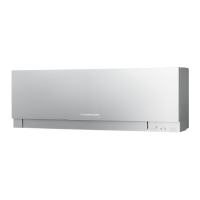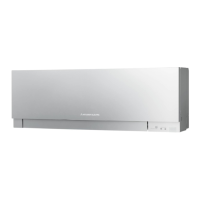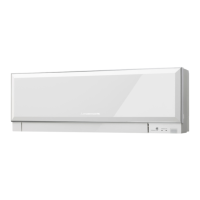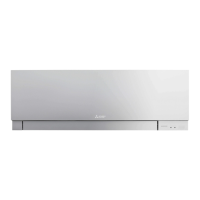
Do you have a question about the Mitsubishi Electric MSZ-EF35VEW and is the answer not in the manual?
| Cooling Capacity | 3.5 kW |
|---|---|
| Heating Capacity | 4.0 kW |
| Seasonal Energy Efficiency Ratio (SEER) | 6.1 |
| Power Supply | 220-240 V, 50 Hz |
| Outdoor Unit Dimensions (W x H x D) | 800 x 550 x 285 mm |
| Energy Efficiency Class Cooling | A++ |
| Energy Efficiency Class Heating | A+ |
| Refrigerant | R32 |
| Coefficient of Performance (COP) | 4.0 |
| Type | Split |
| Noise Level (Indoor) | 19-38 dB(A) |
Explains warning and caution symbols used in the manual for safe operation.
Defines symbols like "Be sure not to do" and "Be sure to follow the instruction".
Details critical safety warnings about electrical connections, cord handling, and operation.
Outlines precautions to prevent minor hazards or damage, like touching fins or using sprays.
Lists further safety warnings regarding operation, batteries, ventilation, and power.
Provides additional cautions on operation, cleaning, and handling.
Highlights the importance of cleaning filters to prevent fungi growth and condensation.
Gives warnings and cautions related to the installation process of the air conditioner.
Instructs to stop operation and consult a dealer in case of abnormal conditions.
Provides information about disposal symbols for EU countries and battery regulations.
Identifies components of the indoor unit, such as front panel, air filters, and vanes.
Details the parts and functions of the remote controller, including display and buttons.
Shows the exterior components of the outdoor unit, like air inlets, piping, and drainage.
Step-by-step guide on how to insert batteries into the remote controller correctly.
Instructions on setting the current time on the remote controller using CLOCK and TIME buttons.
Explains how the unit automatically selects cooling or heating based on room temperature.
Describes the mode for enjoying cool air at a desired temperature setting.
Details the dehumidification mode, which may also cool the room slightly.
Explains how to enjoy warm air at a desired temperature setting.
Describes the mode for circulating air within the room without heating or cooling.
Instructions on how to operate the unit using the emergency operation switch on the indoor unit.
Explains the meaning of different states of the operation indicator lamp on the indoor unit.
Notes on operating multiple indoor units with one outdoor unit, especially regarding mode conflicts.
Describes the function that automatically restarts the unit after a power outage.
Explains how to set the airflow direction for different modes like COOL, DRY, FAN, and HEAT.
Instructions on manually adjusting the vertical vane for horizontal airflow direction.
A note regarding manual adjustment of vertical vanes and returning horizontal vanes to the closed position.
How to select fan speed using the remote controller, including different speed levels.
A note recommending AUTO fan speed for multi-system heating operation.
How to select airflow direction using the VANE button, including AUTO and manual positions.
Provides examples of how to use the i-save function for energy saving and storing settings.
A note about temperature limitations for multi-system units with i-save operation.
Explains the ECONO COOL feature, which saves energy by slightly increasing the set temperature with swing airflow.
Notes on setting ON/OFF timers together and the auto restart function after power failure.
Step-by-step instructions for setting weekly timer schedules for individual days and times.
How to view the programmed weekly timer settings on the remote controller.
General instructions for cleaning, including power precautions and cleaning agents.
How to clean the Nano platinum filter, including frequency and cleaning methods.
Explains the properties and benefits of the Nano platinum filter for air purification.
Instructions for cleaning and replacing the optional air cleaning filter.
Steps for cleaning the front panel of the indoor unit without detaching it.
Important notes regarding cleaning the front panel, avoiding scratches, and handling fingerprints.
Reinforces the importance of regular filter cleaning for performance and preventing fungi.
Lists common symptoms related to the indoor unit and their possible causes or checks.
Troubleshooting for remote controller issues like display problems or lack of response.
Symptoms and checks for when the unit fails to cool or heat effectively.
Troubleshooting for airflow issues, including strange smells and irregular fan operation.
Identifies common sounds like cracking, burbling, or mechanical noises and their causes.
Troubleshooting for weekly timer operation and when the unit starts/stops by itself.
Symptoms related to the outdoor unit, such as fan not rotating or water leakage.
Steps to follow when resuming use after a long period of non-operation.
Advice on suitable and unsuitable locations for installing the air conditioner.
Guidelines for electrical work, including dedicated circuits and breaker capacity.
Notes on rating conditions, noise measurement standards, and specifications for single combinations or multi-systems.












